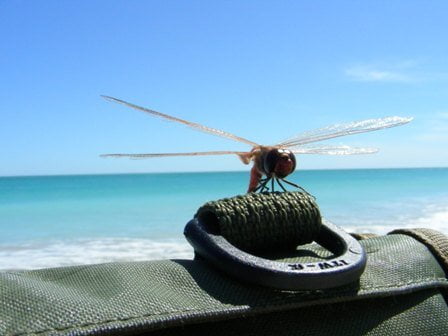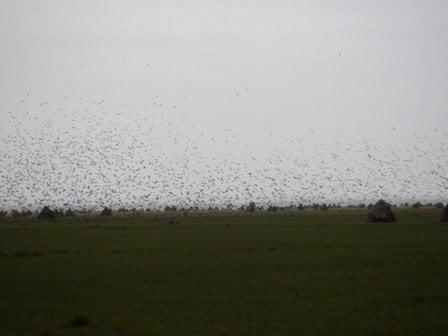After our great holiday in Tasmania we were keen to see the changes around Broome after some substantial rain. We have some wet weather ahead by the looks of things, as we have our cyclone season at the moment. We have been lucky so far, as the cyclones have formed and moved along the coast and not crossed it. The main thing that we noticed as we flew back in was how green everywhere looked after the rains and the large amounts of water sitting on the land. We went for a drive to investigate and it really looks quite lush! There are also dragonflies everywhere, which traditionally means “the end of the Wet”, but in actual fact it means it is two months since the start of the good wet weather. Dragonflies will hatch out after two months, so we will have a bit more “Wet” yet and it’s only teasing us! They are quite happy to rest on your telescope whilst you are birding….
Dragonfly resting on our telescope
The Pied and Sooty Oystercatchers are loafing around on the beaches once the tide comes in and our one surviving chick from the 2010 breeding season is still with it’s parents. The beach has changed dramatically in recent weeks due to the rough seas and there is a lot more sand on the reef, but this is a regular occurrence and everything seems to adapt quite well.
Sooty and Pied Oystercatchers
I thought I would take a short cut through the reef and soon realised I was being watched! I took this photo of an octopus just before it realised it was time to throw ink at me! My legs were a bit black!
Octopus
We have now got freshly hatched locusts all around and hopefully we will see the return of thousands of Oriental Pratincole in coming weeks to eat them. The ground is covered with them as you can see.
Locusts
The huge flocks of Oriental and Australian Pratincoles and Oriental Plovers chasing the locusts on dusk amongst the termite hills is quite a sight. For those of you that are familiar with Starlings and their large flocks and swooping flights you will know what I mean. Thankfully we have managed to keep Starlings out of Western Australia so far.
Oriental Pratincoles feeding amongst the termite mounds
The thousands of shorebirds in Roebuck Bay have started to change into their breeding plumage as they prepare for migration in coming months. They will be heading to Bohai Bay from Broome in a non-stop flight. We will be identifying as many individually marked birds as possible in coming weeks and can expect to have photos of the same birds in China within a week of departing here. Modern cameras enable even metal bands/rings to be read and there are some shorebirds that were individually marked over 20 years ago still making the long trip north. Data collection has been become even more important as the populations of certain species is in decline.
Bar-tailed Godwit “EEP” is recorded!
I will show you the changing colours of the shorebirds over coming weeks.

















Okay, I see through your cunning ways now, Clare: you’ve delivered us with pictures of some of your deadly critters in previous posts to see us prepared for the most deadly thing a birder may encounter on this planet: a picture of a huge, huge flock of Oriental Pratincoles.
*heart attack*
🙂
These are the deadly Kamakazi Oriental Pratincoles! If you are in the way you will be hit!
Seriously, it is the most incredible sight and their discovery a few years ago blew out the statistics-previous “flyway population” thought to be 60,000 and over 3 million (rough estimate!) were following the locust plague south of Broome! They do so much good-farmers love them for all the feasting they do-or there would be nothing left for the cattle to eat! Sadly you never know when they will show up.
Deadly Kamikazi Pratincoles?
Not if the Locusts get you first…